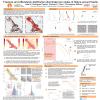Poster #166, Fault and Rupture Mechanics (FARM)
Community Code Comparisons for Simulating Sequences of Earthquakes and Aseismic Slip (SEAS): Exploring Full dynamics and 3D Effects
Poster Image:

Poster Presentation
2020 SCEC Annual Meeting, Poster #166, SCEC Contribution #10593 VIEW PDF
to test the capabilities of different computational methods in correctly solving a mathematically well-defined, basic problem in crustal faulting. BP1 and BP2 consist of a 2D antiplane problem, with quasi-dynamic earthquakes recurring on a 1D planar vertical strike-slip fault obeying rate-and-state friction, embedded in a 2D homogeneous, linear elastic half-space. Our most recent exercises (BP1-FD and BP3) extend this problem to include full dynamics and 3D effects, respectively. For BP1-FD, comparisons of >15 simulation results from 5 groups using different numerical methods, show excellent agreements in long-term and coseismic evolution of fault properties. We found that the truncated domain boundaries influence interseismic fault stressing, earthquake recurrence, and coseismic rupture process, with agreement between models only achieved when model domain size is >5 times the seismogenic depth. For BP3, >20 simulation results from 4 modeling groups showed that recurrence intervals are affected by different computational domain sizes and possibly the choice of time-stepping method. Earthquake nucleation on the fault with uniform frictional properties is particularly sensitive to numerical resolution and schemes, leading to varying nucleation location and rupture directions. However, we did find good agreement in the size and recurrence of earthquakes among simulations with adequate discretization and model domain sizes that provide comparable boundary conditions, despite variability in nucleation and rupture processes. The complexities in 3D problems underscore the need of better strategies for benchmark design and code comparison. These results inform the development of more advanced SEAS models, contributing to our understanding of earthquake system dynamics.
SHOW MORE
SHOW MORE














































































